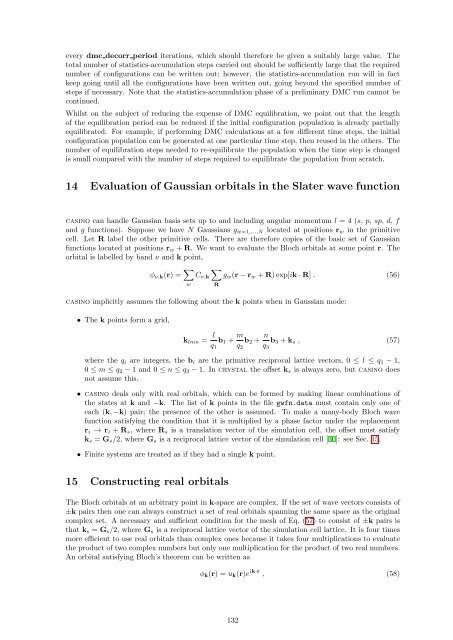CASINO manual - Theory of Condensed Matter
CASINO manual - Theory of Condensed Matter
CASINO manual - Theory of Condensed Matter
Create successful ePaper yourself
Turn your PDF publications into a flip-book with our unique Google optimized e-Paper software.
every dmc decorr period iterations, which should therefore be given a suitably large value. The<br />
total number <strong>of</strong> statistics-accumulation steps carried out should be sufficiently large that the required<br />
number <strong>of</strong> configurations can be written out; however, the statistics-accumulation run will in fact<br />
keep going until all the configurations have been written out, going beyond the specified number <strong>of</strong><br />
steps if necessary. Note that the statistics-accumulation phase <strong>of</strong> a preliminary DMC run cannot be<br />
continued.<br />
Whilst on the subject <strong>of</strong> reducing the expense <strong>of</strong> DMC equilibration, we point out that the length<br />
<strong>of</strong> the equilibration period can be reduced if the initial configuration population is already partially<br />
equilibrated. For example, if performing DMC calculations at a few different time steps, the initial<br />
configuration population can be generated at one particular time step, then reused in the others. The<br />
number <strong>of</strong> equilibration steps needed to re-equilibrate the population when the time step is changed<br />
is small compared with the number <strong>of</strong> steps required to equilibrate the population from scratch.<br />
14 Evaluation <strong>of</strong> Gaussian orbitals in the Slater wave function<br />
casino can handle Gaussian basis sets up to and including angular momentum l = 4 (s, p, sp, d, f<br />
and g functions). Suppose we have N Gaussians g w=1,...,N located at positions r w in the primitive<br />
cell. Let R label the other primitive cells. There are therefore copies <strong>of</strong> the basic set <strong>of</strong> Gaussian<br />
functions located at positions r w + R. We want to evaluate the Bloch orbitals at some point r. The<br />
orbital is labelled by band ν and k point,<br />
φ ν,k (r) = ∑ ∑<br />
C ν,k g w (r − r w + R) exp[ik · R] . (56)<br />
w<br />
casino implicitly assumes the following about the k points when in Gaussian mode:<br />
• The k points form a grid,<br />
R<br />
k lmn = l<br />
q 1<br />
b 1 + m q 2<br />
b 2 + n q 3<br />
b 3 + k s , (57)<br />
where the q i are integers, the b i are the primitive reciprocal lattice vectors, 0 ≤ l ≤ q 1 − 1,<br />
0 ≤ m ≤ q 2 − 1 and 0 ≤ n ≤ q 3 − 1. In crystal the <strong>of</strong>fset k s is always zero, but casino does<br />
not assume this.<br />
• casino deals only with real orbitals, which can be formed by making linear combinations <strong>of</strong><br />
the states at k and −k. The list <strong>of</strong> k points in the file gwfn.data must contain only one <strong>of</strong><br />
each (k, −k) pair; the presence <strong>of</strong> the other is assumed. To make a many-body Bloch wave<br />
function satisfying the condition that it is multiplied by a phase factor under the replacement<br />
r i → r i + R s , where R s is a translation vector <strong>of</strong> the simulation cell, the <strong>of</strong>fset must satisfy<br />
k s = G s /2, where G s is a reciprocal lattice vector <strong>of</strong> the simulation cell [30]: see Sec. 15.<br />
• Finite systems are treated as if they had a single k point.<br />
15 Constructing real orbitals<br />
The Bloch orbitals at an arbitrary point in k-space are complex. If the set <strong>of</strong> wave vectors consists <strong>of</strong><br />
±k pairs then one can always construct a set <strong>of</strong> real orbitals spanning the same space as the original<br />
complex set. A necessary and sufficient condition for the mesh <strong>of</strong> Eq. (57) to consist <strong>of</strong> ±k pairs is<br />
that k s = G s /2, where G s is a reciprocal lattice vector <strong>of</strong> the simulation cell lattice. It is four times<br />
more efficient to use real orbitals than complex ones because it takes four multiplications to evaluate<br />
the product <strong>of</strong> two complex numbers but only one multiplication for the product <strong>of</strong> two real numbers.<br />
An orbital satisfying Bloch’s theorem can be written as<br />
φ k (r) = u k (r)e ik·r , (58)<br />
132

















